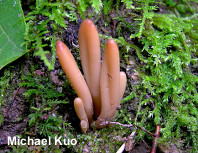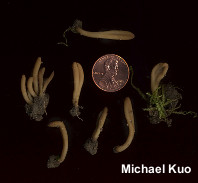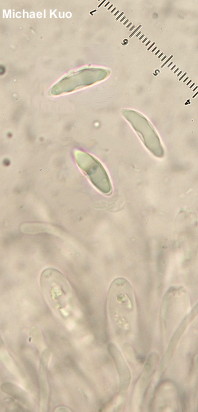| Major Groups > Clubs & Corals > Microglossum olivaceum |

|
Microglossum olivaceum [ Ascomycota > Leotiales > Leotiaceae > Microglossum . . . ] by Michael Kuo Not as stunning as its bright green close relative, Microglossum viride, this species is still interesting and attractive. Apparently, colors for Microglossum olivaceum sometimes range into greenish hues, as the species epithet suggests—but illustrations usually depict yellowish to brownish specimens like the ones illustrated here. The little club-shaped mushrooms also differ from Microglossum viride in their smooth stems, which make it hard to determine where, exactly, the stem ends and the fertile head begins. Microglossum olivaceum is often described in field guides as having septate spores, but my collection's spores were aseptate (at least to my microscope). Mains (1955), who studied 46 collections of the species in her treatment of Microglossum, also noted that "[a]lthough septate spores have been described for this species, none has been seen in this study." Description: Ecology: Traditionally reported as saprobic; growing alone to gregariously in moss under hardwoods; summer and fall; widely distributed in North America; infrequently collected. The illustrated and described collection is from Illinois. Fruiting Body: 15–30 mm high and 2–5 mm wide; club-shaped to somewhat flattened and irregular; head and stem not clearly separated to the naked eye, but under a loupe or dissecting microscope separated by a slight color difference. Head: Cylindric to club-shaped; sometimes becoming somewhat flattened, grooved, or irregular; bald; dull yellow to yellowish brown. Stem: Cylindric; bald; colored like the head but very slightly darker. Flesh: Brownish to yellowish; unchanging when sliced. Odor and Taste: Not distinctive. Chemical Reactions: Iron salts olive, then dark gray on surface of head. Microscopic Features: Spores 12–15 x 3.5–5 µm; subfusiform, with one side a little more flattened than the opposite, more convex side; smooth; with one to several large oil droplets; hyaline in KOH. Asci subclavate; smooth; hyaline to yellowish in KOH; 85–100 µm long. Paraphyses 100–120 x 1.5–2.5 µm; usually projecting; filiform-cylindric; subflexuous; apices subclavate, subcapitate, subacute, or merely rounded; smooth; yellowish to hyaline. REFERENCES: (Persoon, 1796) Gillet, 1879. (Fries, 1821; Saccardo, 1889; Mains, 1955; Smith, Smith & Weber, 1981; Barron, 1999; Wang et al., 2006; Beug et al., 2014; Kučera et al., 2014.) Herb. Kuo 07120808. This site contains no information about the edibility or toxicity of mushrooms. |
© MushroomExpert.Com |
|
Cite this page as: Kuo, M. (2017, September). Microglossum olivaceum. Retrieved from the MushroomExpert.Com Web site: http://www.mushroomexpert.com/microglossum_olivaceum.html |


